
Documentation
BK9053, BK9103
Bus Coupler for PROFINET
2.3.0
2019-08-15
Version:
Date:


Table of contents
BK9053, BK9103 3Version: 2.3.0
Table of contents
1 Foreword ....................................................................................................................................................5
1.1 Notes on the documentation..............................................................................................................5
1.2 Safety instructions .............................................................................................................................6
1.3 Documentation issue status ..............................................................................................................7
2 Product overview.......................................................................................................................................9
2.1 BK9053 - introduction ........................................................................................................................9
2.2 BK9103 - introduction ......................................................................................................................10
2.3 Technical data .................................................................................................................................11
2.4 The Beckhoff Bus Terminal system.................................................................................................11
2.5 The principle of the Bus Terminal....................................................................................................13
3 Mounting and wiring................................................................................................................................14
3.1 Dimensions......................................................................................................................................14
3.2 Installation on mounting rails ...........................................................................................................15
3.3 Power supply, potential groups .......................................................................................................16
3.4 Ethernet connection.........................................................................................................................18
3.5 Ethernet topologies..........................................................................................................................19
3.6 Ethernet cable .................................................................................................................................20
3.7 ATEX - Special conditions (standard temperature range) ...............................................................21
3.8 ATEX - Special conditions (extended temperature range) ..............................................................22
3.9 ATEX Documentation ......................................................................................................................23
4 Parameterization and commissioning...................................................................................................24
4.1 Start-up behaviour of the Bus Coupler ............................................................................................24
4.2 DIP switch settings ..........................................................................................................................25
4.3 Network classes ..............................................................................................................................27
4.4 IP address .......................................................................................................................................28
4.4.1 IP address and PROFINET name ................................................................................... 28
4.4.2 Configuration with KS2000 .............................................................................................. 28
4.4.3 Setting the IP Address Using the Beckhoff BootP Server ............................................... 30
4.4.4 Setting the address using a DHCP server ....................................................................... 31
4.4.5 Subnet mask.................................................................................................................... 31
4.4.6 Testing the IP address..................................................................................................... 31
5 Configuration ...........................................................................................................................................33
5.1 GSDML configuration files...............................................................................................................33
5.2 Mapping the Bus Terminals.............................................................................................................33
5.3 Configuration example with Step 7..................................................................................................33
6 Fieldbus system ......................................................................................................................................36
6.1 Fieldbus Overview ...........................................................................................................................36
6.2 Ethernet ...........................................................................................................................................37
6.3 Topology..........................................................................................................................................39
7 Error handling and diagnosis.................................................................................................................40
7.1 Diagnostic LEDs ..............................................................................................................................40
7.2 Diagnostic word ...............................................................................................................................43

Table of contents
BK9053, BK91034 Version: 2.3.0
8 Appendix ..................................................................................................................................................45
8.1 General operating conditions...........................................................................................................45
8.2 Bibliography.....................................................................................................................................47
8.3 List of Abbreviations ........................................................................................................................47
8.4 Support and Service ........................................................................................................................48

Foreword
BK9053, BK9103 5Version: 2.3.0
1 Foreword
1.1 Notes on the documentation
Intended audience
This description is only intended for the use of trained specialists in control and automation engineering who
are familiar with the applicable national standards.
It is essential that the documentation and the following notes and explanations are followed when installing
and commissioning these components.
It is the duty of the technical personnel to use the documentation published at the respective time of each
installation and commissioning.
The responsible staff must ensure that the application or use of the products described satisfy all the
requirements for safety, including all the relevant laws, regulations, guidelines and standards.
Disclaimer
The documentation has been prepared with care. The products described are, however, constantly under
development.
We reserve the right to revise and change the documentation at any time and without prior announcement.
No claims for the modification of products that have already been supplied may be made on the basis of the
data, diagrams and descriptions in this documentation.
Trademarks
Beckhoff
®
, TwinCAT
®
, EtherCAT
®
, EtherCATG
®
, EtherCATG10
®
, EtherCATP
®
, SafetyoverEtherCAT
®
,
TwinSAFE
®
, XFC
®
, XTS
®
and XPlanar
®
are registered trademarks of and licensed by Beckhoff Automation
GmbH. Other designations used in this publication may be trademarks whose use by third parties for their
own purposes could violate the rights of the owners.
Patent Pending
The EtherCAT Technology is covered, including but not limited to the following patent applications and
patents: EP1590927, EP1789857, EP1456722, EP2137893, DE102015105702 with corresponding
applications or registrations in various other countries.
EtherCAT
®
is registered trademark and patented technology, licensed by Beckhoff Automation GmbH,
Germany.
Copyright
© Beckhoff Automation GmbH & Co. KG, Germany.
The reproduction, distribution and utilization of this document as well as the communication of its contents to
others without express authorization are prohibited.
Offenders will be held liable for the payment of damages. All rights reserved in the event of the grant of a
patent, utility model or design.

Foreword
BK9053, BK91036 Version: 2.3.0
1.2 Safety instructions
Safety regulations
Please note the following safety instructions and explanations!
Product-specific safety instructions can be found on following pages or in the areas mounting, wiring,
commissioning etc.
Exclusion of liability
All the components are supplied in particular hardware and software configurations appropriate for the
application. Modifications to hardware or software configurations other than those described in the
documentation are not permitted, and nullify the liability of Beckhoff Automation GmbH & Co. KG.
Personnel qualification
This description is only intended for trained specialists in control, automation and drive engineering who are
familiar with the applicable national standards.
Description of instructions
In this documentation the following instructions are used.
These instructions must be read carefully and followed without fail!
DANGER
Serious risk of injury!
Failure to follow this safety instruction directly endangers the life and health of persons.
WARNING
Risk of injury!
Failure to follow this safety instruction endangers the life and health of persons.
CAUTION
Personal injuries!
Failure to follow this safety instruction can lead to injuries to persons.
NOTE
Damage to environment/equipment or data loss
Failure to follow this instruction can lead to environmental damage, equipment damage or data loss.
Tip or pointer
This symbol indicates information that contributes to better understanding.

Foreword
BK9053, BK9103 7Version: 2.3.0
1.3 Documentation issue status
Version Modifications
2.3.0 • Update chapter Foreword
2.2.0 • Update chapter IP address
• Update Technical data
• ATEX - Special conditions (extended temperature range) added
2.1.0 • Update Technical data
• Update structure
2.0.0 • Migration
• Update structure
1.3.1 • Firmware update
1.3.0 • Description of diagnostic D-words added
• ATEX notes added
1.2.0 • BK9053 added
1.1.0 • Firmware B2 update
1.0.0 • First version
Firmware and hardware versions
Documentation
Version
BK9053 BK9103
Firmware Hardware* Firmware Hardware*
2.2.0 B9 06 C1 11
2.1.0 B9 06 C1 11
2.0.0 B8 04 C0 11
1.3.1 B5 00 BD 06
1.3.0 B2 00 BA 06
1.2.0 B1 00 B7 06
1.1.0 - - B2 00
1.0.0 - - B0 00
Minimum hardware* required for update.
You can determine which firmware was fitted when the Bus Coupler left the factory from the adhesive label
underneath (see the fifth and sixth figures of the production number).
Sample:
3200B2020000
The firmware in the example is B2.
The KS2000 configuration software and the corresponding serial cable included with, is required for updating
your firmware.
New firmware versions can be found at http://www.beckhoff.de.

Foreword
BK9053, BK91038 Version: 2.3.0
Notes on the firmware versions
BK9103
Firmware Description
C0 • Supported terminals - KL6781, KL8519, KL8524, KL8528 and KL8548
BF • The record index 0x1010 can be used to deselect a parametrization (= write) of the
K-bus -> e.g. for the IO-Link terminal
BE • Internal buffer for frames increased
BD • Support compact mapping for KL6051
• After a K-bus reset via KS2000 or DAP Ctrl the AR is always disassembled
• Only one LLDP is accepted; the REMMIB is not deleted and a new neighbor is not
accepted until the TTL has elapsed
BC • Reading of the RemPort MIB rectified (via SNMP)
BB • GSDML for Schema V2.3
• MRP client is now supported
• Multiple write is supported
BA • In the event of a pull/plug alarm only the states of the affected modules are set to
BAD/GOOD
B9 • Support of KL6224 (IO-Link master)
B8 • I&M2 and I&M3 supported
B7 • HD terminals included
B6 • KL2791, KL1212, KL2641 implemented
• Step 7 online view supported
B5 • Alias name revised
B4 • LLDP, SNMP implemented
• I&M0, I&M1, I&M4 supported
B3 • Support for all KL terminals
B2 • Support for new Bus Terminals implemented.
• KL3xxx and KL4xxx can now also be entered in compact form.
B0 • First published
BK9053
Firmware Description
• Supported terminals - KL6781, KL8519, KL8524, KL8528 and KL8548
B7 • The record index 0x1010 can be used to deselect a parametrization (= write) of the
K-bus -> e.g. for the IO-Link terminal
B6 • Internal buffer for frames increased
B5 • Support compact mapping for KL6051
• After a K-bus reset via KS2000 or DAP Ctrl the AR is always disassembled
• Only one LLDP is accepted; the REMMIB is not deleted and a new neighbor is not
accepted until the TTL has elapsed
B4 • Reading of the RemPort MIB rectified (via SNMP)
B3 • Support of KL6224 (IO-Link master)
• GSDML for Schema V2.3
B2 • Firmware released
B0 • First publication (preliminary)

Product overview
BK9053, BK9103 9Version: 2.3.0
2 Product overview
2.1 BK9053 - introduction
Fig.1: BK9053
PROFINET is the open Industrial Ethernet-standard of the PNO (PROFIBUS User Organisation).
Internationally established IT standards are used for communication.
PROFINET IO describes data exchange between controllers and field devices. It can be used in standard
Ethernet networks and networked via commercially available switches. Linking to any PROFINET controller
takes place via the GSDML basic device file.
The BK9053 Bus Coupler connects PROFINET with the modular, extendable electronic terminal blocks. A
unit consists of a Bus Coupler, any number (between 1 and 64) of terminals (255 with K-bus extension) and
one end terminal.
The Bus Couplers recognize the terminals to which they are connected, and perform the assignment of the
inputs and outputs to the words of the process image automatically.

Product overview
BK9053, BK910310 Version: 2.3.0
2.2 BK9103 - introduction
Fig.2: BK9103
The BK9103 Bus Coupler connects PROFINET with the modular, extendable electronic terminal blocks. A
unit consists of a Bus Coupler, any number (between 1 and 64) of terminals, and a bus end terminal (255
Bus Terminals with Terminal Bus extension).
The Bus Couplers recognize the terminals to which they are connected, and perform the assignment of the
inputs and outputs to the words of the process image automatically.
The BK9103 Bus Coupler supports 10 Mbit/s and 100 Mbit/s Ethernet. Connection is through normal RJ 45
connectors. The IP address is set on a DIP switch (the offset from a freely selectable start address). In
networks with DHCP (a service for the allocation of the logical IP address to the physical node address
(MAC-ID)) the Bus Coupler obtains its IP address from the DHCP server.
The BK9103 has an additional RJ-45 port. Both Ethernet ports operate as 2-channel switches. The I/O
stations can thus be configured with a line topology, instead of the classic star topology. In many
applications; this significantly reduces the wiring effort and the cabling costs. The maximum distance
between two couplers is 100 m. Up to 20 BK9103 Bus Couplers are cascadable, so that a maximum line
length of 2 km can be achieved.
Complex signal processing for analog I/Os, displacement measurement, etc.
The BK9000 Bus Coupler supports operation of all K-Bus Terminals. As far as the user is concerned, the
inputs and outputs are not handled any differently from the way they are by other coupler series. The
information is made available for use as a byte array in the process image of the automation device.
The KS2000 configuration software allows the analog and multifunctional Bus Terminals to be adapted to the
specific application. Depending on the particular type, the registers in the analog Bus Terminals contain
temperature ranges, amplification factors and linearization curves. The KS2000 software can be used to set
the desired paramétrisation via the PC. The Bus Terminal stores the setting permanently, even if the voltage
supply fails. Having the controller (PLC, IPC) carry out the configuration of the Bus Terminals is a further
option. The PLC or IPC uses function blocks (FB) to take care of the configuration of all the peripherals
during the start-up phase. The controller can, if required, upload the non-centrally generated configuration

Product overview
BK9053, BK9103 11Version: 2.3.0
data in order to manage and store them centrally. This means that it is not necessary to carry out the setting
procedure again if a Bus Terminal is exchanged. The controller carries out the desired setting automatically
after switching on.
2.3 Technical data
System
System data BK9053 BK9103
Number of I/O modules only limited by the IP address space
Number of I/O points depending on controller
Transmission medium Twisted pair copper cable, 4 x 2, shielded; category 5 (100Mbaud)
Distance between modules 100m (between switch and Bus Coupler)
Data transfer rate 10/100Mbaud
Topology line or star wiring
Cascading up to 20 Bus Couplers (max. line length 2km)
Bus Coupler
Technical data BK9053 BK9103
Number of Bus Terminals 64 (255 with K-bus extension)
Digital peripheral signals 512 inputs/outputs 512 inputs/outputs
Analog peripheral signals 256 inputs/outputs 256 inputs/outputs
Protocols PROFINET RT (class B)
TCP-ADS for access via Ethernet with KS2000 configuration software
Configuration possibility Via the KS2000 configuration software or the controller
Maximum number of bytes 512 bytes of input data and 512 bytes of output data
Bus connection 1 x RJ45 2 x RJ45
Power supply 24V
DC
(-15%/+20%)
Current consumption 70mA + (total K bus current)/4, max. 500mA
Starting current approx. 2.5 x continuous current
K-Bus power supply up to 1750mA
Power contact voltage maximal 24V
DC
Power contact current load maximal 10A
Dielectric strength 500V (power contact/supply voltage/Ethernet/fieldbus)
Recommended fuse ≤10A
Weight approx.100g approx. 170g
Mounting [}15]
on 35mm mounting rail conforms to EN 60715
Permissible ambient temperature range dur-
ing operation
0 °C ... +55 °C -25 °C ... +60 °C
Permissible ambient temperature range dur-
ing storage
-25 °C ... +85 °C -40 °C ... +85 °C
Permissible relative humidity 95%, no condensation
Vibration/shock resistance conforms to EN 60068-2-6 / EN 60068-2-27
EMC immunity/emission conforms to EN 61000-6-2 / EN 61000-6-4
Installation position variable
Protection class IP20
Approvals
CE, UL, ATEX [}21] CE, UL, ATEX [}22], GL
2.4 The Beckhoff Bus Terminal system
Up to 256 Bus Terminals, with 1 to 16I/O channels per signal form
The Bus Terminal system is the universal interface between a fieldbus system and the sensor / actuator
level. A unit consists of a Bus Coupler as the head station, and up to 64 electronic series terminals, the last
one being an end terminal. Up to 255 Bus Terminals can be connected via the K-bus extension. For each

Product overview
BK9053, BK910312 Version: 2.3.0
technical signal form, terminals are available with one, two, four or eight I/O channels, which can be mixed
as required. All the terminal types have the same mechanical construction, so that difficulties of planning and
design are minimized. The height and depth match the dimensions of compact terminal boxes.
Decentralised wiring of each I/O level
Fieldbus technology allows more compact forms of controller to be used. The I/O level does not have to be
brought to the controller. The sensors and actuators can be wired decentrally, using minimum cable lengths.
The controller can be installed at any location within the plant.
Industrial PCs as controllers
The use of an Industrial PC as the controller means that the operating and observing element can be
implemented in the controller's hardware. The controller can therefore be located at an operating panel, in a
control room, or at some similar place. The Bus Terminals form the decentralised input/output level of the
controller in the control cabinet and the subsidiary terminal boxes. The power sector of the plant is also
controlled over the bus system in addition to the sensor/actuator level. The Bus Terminal replaces the
conventional series terminal as the wiring level in the control cabinet. The control cabinet can have smaller
dimensions.
Bus Couplers for all usual bus systems
The Beckhoff Bus Terminal system unites the advantages of a bus system with the possibilities of the
compact series terminal. Bus Terminals can be driven within all the usual bus systems, thus reducing the
controller parts count. The Bus Terminals then behave like conventional connections for that bus system. All
the performance features of the particular bus system are supported.
Mounting on standardized mounting rails
The installation is standardized thanks to the simple and space-saving mounting on a standardized mounting
rail (EN60715, 35mm) and the direct wiring of actuators and sensors, without cross connections between
the terminals. The consistent labelling scheme also contributes.
The small physical size and the great flexibility of the Bus Terminal system allow it to be used wherever a
series terminal is also used. Every type of connection, such as analog, digital, serial or the direct connection
of sensors can be implemented.
Modularity
The modular assembly of the terminal strip with Bus Terminals of various functions limits the number of
unused channels to a maximum of one per function. The presence of two channels in one terminal is the
optimum compromise of unused channels and the cost of each channel. The possibility of electrical isolation
through potential feed terminals also helps to keep the number of unused channels low.
Display of the channel state
The integrated LEDs show the state of the channel at a location close to the sensors and actuators.
K-bus
The K-bus is the data path within a terminal strip. The K-bus is led through from the Bus Coupler through all
the terminals via six contacts on the terminals' side walls. The end terminal terminates the K-bus. The user
does not have to learn anything about the function of the K-bus or about the internal workings of the
terminals and the Bus Coupler. Many software tools that can be supplied make project planning,
configuration and operation easy.
Potential feed terminals for isolated groups
The operating voltage is passed on to following terminals via three power contacts. You can divide the
terminal strip into arbitrary isolated groups by means of potential feed terminals. The potential feed terminals
play no part in the control of the terminals, and can be inserted at any locations within the terminal strip.

Product overview
BK9053, BK9103 13Version: 2.3.0
Up to 64Bus Terminals can be used in a terminal block, with optional K-bus extension for up to 256Bus
Terminals. This count does include potential feed terminals, but not the end terminal.
Bus Couplers for various fieldbus systems
Various Bus Couplers can be used to couple the electronic terminal strip quickly and easily to different
fieldbus systems. It is also possible to convert to another fieldbus system at a later time. The Bus Coupler
performs all the monitoring and control tasks that are necessary for operation of the connected Bus
Terminals. The operation and configuration of the Bus Terminals is carried out exclusively by the Bus
Coupler. Nevertheless, the parameters that have been set are stored in each Bus Terminal, and are retained
in the event of voltage drop-out. Fieldbus, K-bus and I/O level are electrically isolated.
If the exchange of data over the fieldbus is prone to errors or fails for a period of time, register contents (such
as counter states) are retained, digital outputs are cleared, and analog outputs take a value that can be
configured for each output when commissioning. The default setting for analog outputs is 0 V or 0 mA. Digital
outputs return in the inactive state. The timeout periods for the Bus Couplers correspond to the usual
settings for the fieldbus system. When converting to a different bus system it is necessary to bear in mind the
need to change the timeout periods if the bus cycle time is longer.
The interfaces
A Bus Coupler has six different methods of connection. These interfaces are designed as plug connectors
and as spring-loaded terminals.
2.5 The principle of the Bus Terminal
Fig.3: The principle of the Bus Terminal

Mounting and wiring
BK9053, BK910314 Version: 2.3.0
3 Mounting and wiring
3.1 Dimensions
The system of the Beckhoff Bus Terminals is characterized by low physical volume and high modularity.
When planning a project it must be assumed that at least one Bus Coupler and a number of Bus Terminals
will be used. The mechanical dimensions of the Bus Couplers are independent of the fieldbus system.
Fig.4: Dimensions
The total width in practical cases is composed of the width of the Bus Coupler, the KL9010 Bus End
Terminal and the width of the bus terminals in use. Depending on function, the Bus Terminals are 12 or
24mm wide. The front wiring increases the total height of 68 mm by about 5 to 10mm, depending on the
wire thickness.
Mechanical data BKxxxx
BCxxxx
BKxx50
BCxx50
BXxxxx LCxxxx
Design form compact terminal housing with signal LED
Material Polyamide
(PA 6.6)
Polyamide
(PA 6.6)
Polycarbonate Polyamide
(PA 6.6)
Dimensions (W x H x D) 49 x 100 x 68mm 44 x 100 x 68mm 81 (BX8000 61) x 100 x
89mm
21 x 100 x 68mm
Mounting on 35 mm C-rail in accordance with EN 60715 with latching
Stackable by Double groove-tongue connection
Labelling Standard terminal block labelling
Vibration/shock
resistance
conforms to EN 60068-2-6 / EN 60068-2-27
EMC immunity/
emission
conforms to EN 61000-6-2 / EN 61000-6-4

Mounting and wiring
BK9053, BK9103 15Version: 2.3.0
Connection technology BKxxxx
BCxxxx
BKxx50
BCxx50
BXxxxx LCxxxx
Wiring Cage Clamp® spring-loaded system
Connection cross-section 0.08mm² ... 2.5 mm², stranded, solid wire, 28-14 AWG
Fieldbus connection depending on fieldbus spring-loaded terminals
Power contacts 3 spring contacts
Current loading IMAXX 10 A (125 A short circuit)
Rated voltage 24V
DC
3.2 Installation on mounting rails
WARNING
Risk of injury through electric shock and damage to the device!
Bring the Bus Terminals system into a safe, de-energized state before starting mounting, disassembly or
wiring of the Bus Terminals.
Mounting
The Bus Couplers and Bus Terminals are attached to commercially available 35mm mounting rails (DIN rail
according to EN60715) by applying slight pressure:
1. First attach the Fieldbus Coupler to the mounting rail.
2. The Bus Terminals are now attached on the right-hand side of the fieldbus Coupler. Join the compo-
nents with slot and key and push the terminals against the mounting rail, until the lock clicks onto the
mounting rail.
If the terminals are clipped onto the mounting rail first and then pushed together without tongue and
groove, the connection will not be operational! When correctly assembled, no significant gap should
be visible between the housings.
Fixing of mounting rails
The locking mechanism of the terminals and couplers extends to the profile of the mounting rail. At
the installation, the locking mechanism of the components must not come into conflict with the fixing
bolts of the mounting rail. To mount the mounting rails with a height of 7.5mm under the terminals
and couplers, you should use flat mounting connections (e.g. countersunk screws or blind rivets).
Disassembly
Each terminal is secured by a lock on the mounting rail, which must be released for disassembly:
1. Carefully pull the orange-colored lug approximately 1cm out of the terminal to be disassembled, until
it protrudes loosely. The lock with the mounting rail is now released for this terminal, and the terminal
can be pulled from the mounting rail without excessive force.
2. Grasp the released terminal with thumb and index finger simultaneous at the upper and lower grooved
housing surfaces and pull the terminal away from the mounting rail.
Connections within a Bus Terminal block
The electric connections between the Bus Coupler and the Bus Terminals are automatically realized by
joining the components:
• The six spring contacts of the K-Bus/E-Bus deal with the transfer of the data and the supply of the Bus
Terminal electronics.
• The power contacts deal with the supply for the field electronics and thus represent a supply rail within
the Bus Terminal block. The power contacts are supplied via terminals on the Bus Coupler.

Mounting and wiring
BK9053, BK910316 Version: 2.3.0
Power contacts
During the design of a Bus Terminal block, the pin assignment of the individual Bus Terminals must
be taken account of, since some types (e.g. analog Bus Terminals or digital 4-channel Bus Termi-
nals) do not or not fully loop through the power contacts. Power Feed Terminals (KL91xx, KL92xx
and EL91xx, EL92xx) interrupt the power contacts and thus represent the start of a new supply rail.
PE power contact
The power contact labelled PE can be used as a protective earth. For safety reasons this contact mates first
when plugging together, and can ground short-circuit currents of up to 125A.
NOTE
Risk of damage to the device
Note that, for reasons of electromagnetic compatibility, the PE contacts are capacitatively coupled to the
mounting rail. This may lead to incorrect results during insulation testing or to damage on the terminal (e.g.
disruptive discharge to the PE line during insulation testing of a consumer with a nominal voltage of 230V).
For insulation testing, disconnect the PE supply line at the Bus Coupler or the Power Feed Terminal! In or-
der to decouple further feed points for testing, these Power Feed Terminals can be released and pulled at
least 10mm from the group of terminals.
WARNING
Risk of electric shock!
The PE power contact must not be used for other potentials!
Wiring
Up to eight connections enable the connection of solid or finely stranded cables to the Bus Terminals. The
terminals are implemented in spring force technology. Connect the cables as follows:
1. Open a spring-loaded terminal by slightly pushing with a screwdriver or a rod into the square opening
above the terminal.
2. The wire can now be inserted into the round terminal opening without any force.
3. The terminal closes automatically when the pressure is released, holding the wire safely and perma-
nently.
Shielding
Analog sensors and actuators should always be connected with shielded, pair-wise twisted cables.
3.3 Power supply, potential groups
Power supply for the Bus Coupler
The Bus Couplers require a 24 V
DC
supply for their operation. The connection is made by means of the upper
spring-loaded terminals labelled 24V and 0V. The supply voltage feeds the Bus Coupler electronics and,
over the K-Bus/E-Bus, the Bus Terminals. The power supply for the Bus Coupler electronics and that of the
K-Bus/E-Bus are electrically separated from the potential of the field level.
Power supply for the power contacts
The bottom six connections with spring-loaded terminals can be used to feed the supply for the peripherals.
The spring-loaded terminals are joined in pairs to a power contact. The feed for the power contacts has no
connection to the voltage supply for the Bus Coupler. The design of the feed permits voltages of up to 24V.
The assignment in pairs and the electrical connection between feed terminal contacts allows the connection
wires to be looped through to various terminal points. The current drawn from the power contacts must not
exceed 10A for long periods. The current carrying capacity between two spring-loaded terminals is identical
to that of the connecting wires.

Mounting and wiring
BK9053, BK9103 17Version: 2.3.0
Power contacts
On the right hand face of the Bus Coupler there are three spring contacts for the power contact connections.
The spring contacts are hidden in slots so that they cannot be accidentally touched. By attaching a Bus
Terminal the blade contacts on the left hand side of the Bus Terminal are connected to the spring contacts.
The tongue and groove guides on the top and bottom of the Bus Coupler and of the Bus Terminals
guarantees that the power contacts mate securely.
Configuration interface (not for BK1250, EK1x00)
The standard Bus Couplers have an RS232 interface at the bottom of the front face. The miniature connector
can be joined to a PC with the aid of a connecting cable and the KS2000 configuration software. The
interface permits the Bus Terminals to be configured, for example adjusting the amplification factors of the
analog channels. The interface can also be used to change the assignments of the bus terminal data to the
process image in the Bus Coupler. The functionality of the configuration interface can also be reached via
the fieldbus using string communication facility.
Electrical isolation
The bus couplers operate by means of three independent potential groups. The supply voltage feeds the K-
Bus/E-Bus electronics in the Bus Coupler and the K-Bus/E-Bus itself in an electrically isolated manner. The
supply voltage is also used to generate the operating voltage for the fieldbus.
Note: All Bus Terminals are electrically isolated from the K-Bus/E-bus. The K-Bus/E-bus is therefore
completely electrically isolated.
Fig.5: Electrical isolation

Mounting and wiring
BK9053, BK910318 Version: 2.3.0
3.4 Ethernet connection
The connection to the Ethernet bus is made via an RJ45 connector (a Western plug).
Fig.6: RJ45 connector
Cabling
Ethernet connection from PC to BK910x via a switch
Fig.7: Ethernet connection from PC to BK910x via a switch
Connect the PC's network card to the hub using a standard Ethernet cable, and connect the hub, again using
a standard Ethernet cable, to the Bus Terminal controller. Connection via a switch is done in the same way.
Direct Ethernet connection from PC to BK910x
Fig.8: Direct Ethernet connection from PC to BK910x
A standard Ethernet cable must be used for connecting the PC directly with the Bus Terminal Controller.
Pin assignment of the RJ45 plug
PIN Signal Description
1 TD + Transmit +
2 TD - Transmit -
3 RD + Receive +
4 - reserved
5 - reserved
6 RD - Receive -
7 - reserved
8 - reserved

Mounting and wiring
BK9053, BK9103 19Version: 2.3.0
3.5 Ethernet topologies
BK9053
Since the BK9053 has only one port, a conventional star topology must be used.
BK9103
The BK9103 features an internal triple switch with two external ports and one internal port. The internal
switch facilitates creation of a line topology. A maximum of 20 BK9103s can be connected in series in a
physical line. The maximum distance between two BK9103s is 100 m. The maximum overall line length is
therefore 2 km. No further switch may be included in this line.
Fig.9: Ethernet topology with several BK9103 in two lines
The BK9103 also enables a classic star topology to be set up. In this case the second port is not used. Both
port interfaces are equivalent.

Mounting and wiring
BK9053, BK910320 Version: 2.3.0
3.6 Ethernet cable
Transmission standards
10Base5
The transmission medium for 10Base5 consists of a thick coaxial cable ("yellow cable") with a max.
transmission speed of 10Mbaud arranged in a line topology with branches (drops) each of which is
connected to one network device. Because all the devices are in this case connected to a common
transmission medium, it is inevitable that collisions occur often in 10Base5.
10Base2
10Base2 (Cheaper net) is a further development of 10Base5, and has the advantage that the coaxial cable is
cheaper and, being more flexible, is easier to lay. It is possible for several devices to be connected to one
10Base2 cable. It is frequent for branches from a 10Base5 backbone to be implemented in 10Base2.
10BaseT
Describes a twisted pair cable for 10Mbaud. The network here is constructed as a star. It is no longer the
case that every device is attached to the same medium. This means that a broken cable no longer results in
failure of the entire network. The use of switches as star couplers enables collisions to be reduced. Using
full-duplex connections they can even be entirely avoided.
100BaseT
Twisted pair cable for 100Mbaud. It is necessary to use a higher cable quality and to employ appropriate
hubs or switches in order to achieve the higher data rate.
10BaseF
The 10BaseF standard describes several optical fiber versions.
Short description of the 10BaseT and 100BaseT cable types
Twisted-pair copper cable for star topologies, where the distance between two devices may not exceed 100
meters.
UTP
Unshielded twisted pair
This type of cable belongs to category 3, and is not recommended for use in an industrial environment.
S/UTP
Screened/unshielded twisted pair (screened with copper braid)
Has an overall shield of copper braid to reduce influence of external interference. This cable is
recommended for use with Bus Couplers.
FTP
Foiled shielded twisted pair (screened with aluminium foil)
This cable has an outer screen of laminated aluminium and plastic foil.
S/FTP
Screened/foiled-shielded twisted pair (screened with copper braid and aluminium foil)
Has a laminated aluminium screen with a copper braid on top. Such cables can provide up to 70dB
reduction in interference power.
Page is loading ...
Page is loading ...
Page is loading ...
Page is loading ...
Page is loading ...
Page is loading ...
Page is loading ...
Page is loading ...
Page is loading ...
Page is loading ...
Page is loading ...
Page is loading ...
Page is loading ...
Page is loading ...
Page is loading ...
Page is loading ...
Page is loading ...
Page is loading ...
Page is loading ...
Page is loading ...
Page is loading ...
Page is loading ...
Page is loading ...
Page is loading ...
Page is loading ...
Page is loading ...
Page is loading ...
Page is loading ...
Page is loading ...
-
 1
1
-
 2
2
-
 3
3
-
 4
4
-
 5
5
-
 6
6
-
 7
7
-
 8
8
-
 9
9
-
 10
10
-
 11
11
-
 12
12
-
 13
13
-
 14
14
-
 15
15
-
 16
16
-
 17
17
-
 18
18
-
 19
19
-
 20
20
-
 21
21
-
 22
22
-
 23
23
-
 24
24
-
 25
25
-
 26
26
-
 27
27
-
 28
28
-
 29
29
-
 30
30
-
 31
31
-
 32
32
-
 33
33
-
 34
34
-
 35
35
-
 36
36
-
 37
37
-
 38
38
-
 39
39
-
 40
40
-
 41
41
-
 42
42
-
 43
43
-
 44
44
-
 45
45
-
 46
46
-
 47
47
-
 48
48
-
 49
49
Beckhoff BK9053 Documentation
- Type
- Documentation
- This manual is also suitable for
Ask a question and I''ll find the answer in the document
Finding information in a document is now easier with AI
Related papers
-
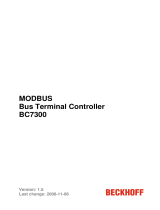 Beckhoff BC7300 User manual
Beckhoff BC7300 User manual
-
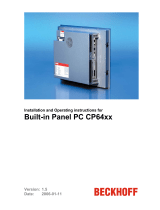 Beckhoff CP64 Series Installation And Operating Instructions Manual
Beckhoff CP64 Series Installation And Operating Instructions Manual
-
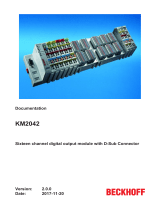 Beckhoff KM2042 Documentation
Beckhoff KM2042 Documentation
-
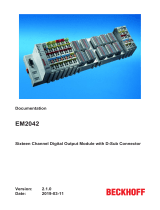 Beckhoff EM2042 Documentation
Beckhoff EM2042 Documentation
-
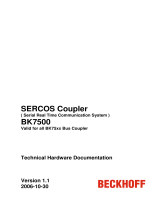 Beckhoff BK75 series Technical Hardware Documentation
Beckhoff BK75 series Technical Hardware Documentation
-
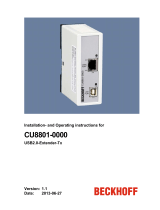 Beckhoff CU8801-0000 Installation And Operating Instructions For
Beckhoff CU8801-0000 Installation And Operating Instructions For
-
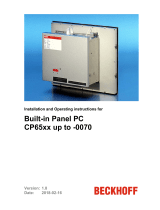 Beckhoff CP65**-0070 Installation And Operating Instructions Manual
Beckhoff CP65**-0070 Installation And Operating Instructions Manual
-
Beckhoff KL8528 Documentation
-
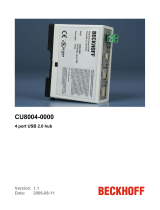 Beckhoff CU8004-0000 User manual
Beckhoff CU8004-0000 User manual
-
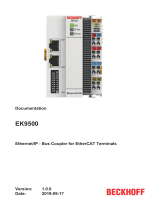 Beckhoff EK9500 Documentation
Beckhoff EK9500 Documentation
Other documents
-
Morningstar EMC-1 Quick start guide
-
AUMA Actuator controls SGC User manual
-
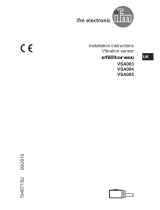 IFM Electronic VSA003 Installation guide
IFM Electronic VSA003 Installation guide
-
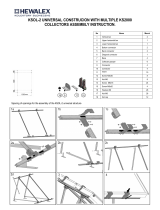 Hewalex KSOL-2 Assembly Instruction
Hewalex KSOL-2 Assembly Instruction
-
Contec IPC-PSD-20 Owner's manual
-
Helmholz Profinet 700-850-8PS01 User manual
-
Toshiba EN661 Operating instructions
-
ABB Foundation LD 810HSE Ex Quick Installation Manual
-
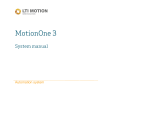 Korber Solutions LTI MOTION MotionOne 3 System Manual
Korber Solutions LTI MOTION MotionOne 3 System Manual
-
SICK CDM425-10234094 CDM425-00034094 Connection Modules Operating instructions




























































